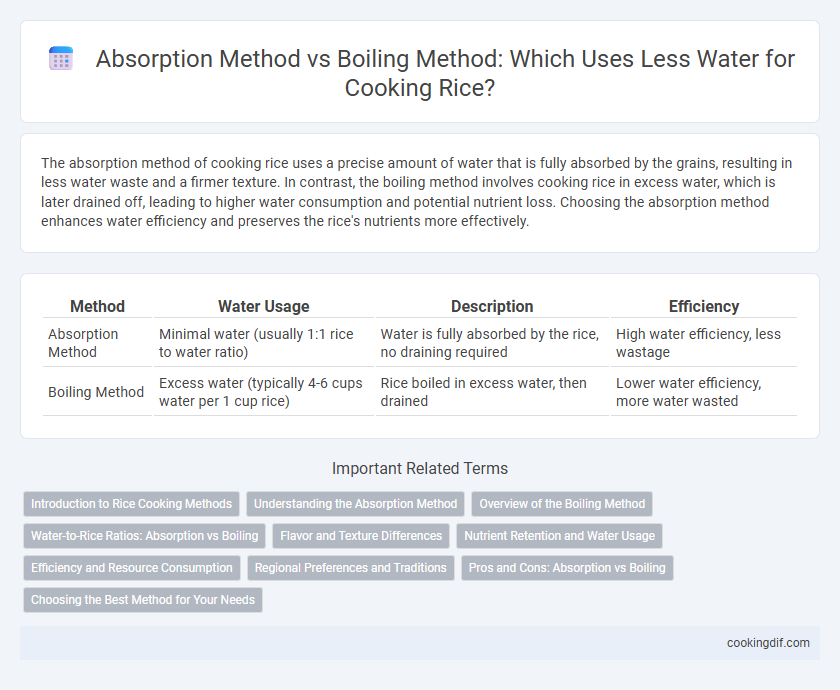The absorption method of cooking rice uses a precise amount of water that is fully absorbed by the grains, resulting in less water waste and a firmer texture. In contrast, the boiling method involves cooking rice in excess water, which is later drained off, leading to higher water consumption and potential nutrient loss. Choosing the absorption method enhances water efficiency and preserves the rice's nutrients more effectively.
Table of Comparison
| Method | Water Usage | Description | Efficiency |
|---|---|---|---|
| Absorption Method | Minimal water (usually 1:1 rice to water ratio) | Water is fully absorbed by the rice, no draining required | High water efficiency, less wastage |
| Boiling Method | Excess water (typically 4-6 cups water per 1 cup rice) | Rice boiled in excess water, then drained | Lower water efficiency, more water wasted |
Introduction to Rice Cooking Methods
The absorption method for cooking rice uses a measured amount of water that is completely absorbed by the rice, resulting in fluffy, evenly cooked grains with minimal water waste. The boiling method involves cooking rice in excess water, which is later drained, often leading to higher water usage and potential nutrient loss. Understanding these methods helps optimize water efficiency and rice texture according to culinary preferences.
Understanding the Absorption Method
The absorption method for cooking rice involves using a measured amount of water that is fully absorbed during cooking, resulting in tender and evenly cooked grains without excess water waste. This technique typically requires precise water-to-rice ratios, such as 1.5 to 2 cups of water per cup of rice, depending on the rice variety, ensuring efficient water usage compared to the boiling method. Unlike the boiling method, which discards excess water and can lead to nutrient loss, the absorption method retains more nutrients and flavors by cooking rice in a controlled water environment.
Overview of the Boiling Method
The boiling method for cooking rice involves submerging rice in excess water, which is later drained to remove residual starch and impurities, resulting in fluffier grains. This method generally requires more water compared to the absorption method, typically using a water-to-rice ratio of about 6:1, enhancing the rinsing effect and reducing stickiness. It is popular in cuisines that favor light, non-sticky textures and allows for larger batch cooking with consistent results.
Water-to-Rice Ratios: Absorption vs Boiling
The absorption method uses a precise water-to-rice ratio, typically 2:1, allowing rice to absorb all water during cooking, resulting in less water waste. In contrast, the boiling method involves using a larger volume of water--often 6:1 or more--which is drained off after cooking, leading to higher water consumption. Efficiency in water usage is significantly greater with the absorption method compared to the boiling method.
Flavor and Texture Differences
The absorption method retains more water and rice nutrients, resulting in a fluffy texture with enhanced natural flavor absorption, whereas the boiling method uses excess water that is drained away, often leading to softer, less flavorful grains. The absorption technique allows rice to cook evenly as it absorbs all the water, preserving the aromatic compounds and producing a distinct texture ideal for pilafs and risottos. Boiling tends to dilute flavor and can create a mushier texture, making it suitable for dishes where rice is mixed with other strong-flavored ingredients.
Nutrient Retention and Water Usage
The Absorption Method retains more nutrients in rice by allowing grains to absorb all the cooking water, minimizing nutrient loss compared to the Boiling Method where excess water is discarded. Water usage is more efficient with the Absorption Method, requiring precise water-to-rice ratios, while the Boiling Method uses significantly larger volumes of water and results in higher water waste. Studies have shown nutrient retention in the Absorption Method can be up to 30% higher due to reduced leaching of water-soluble vitamins and minerals.
Efficiency and Resource Consumption
The absorption method uses a measured amount of water that is fully absorbed by the rice, resulting in higher water efficiency and minimal resource waste compared to the boiling method. The boiling method requires excess water that is later drained, leading to significant water consumption and potential nutrient loss. Choosing the absorption method reduces water usage by up to 30%, promoting sustainable cooking practices.
Regional Preferences and Traditions
The Absorption Method, commonly used in Asian countries like Japan and China, involves cooking rice with a precise water-to-rice ratio, allowing water to be fully absorbed, which preserves nutrients and enhances texture. In contrast, the Boiling Method, preferred in Middle Eastern and some European regions, involves cooking rice in excess water that is later drained, catering to traditional dishes where fluffier and less sticky rice is desired. Regional preferences hinge on culinary traditions, with the Absorption Method emphasizing moisture retention and the Boiling Method favoring texture control, both deeply rooted in local dietary customs.
Pros and Cons: Absorption vs Boiling
The Absorption Method requires precise water measurement, allowing rice to absorb all the liquid, which minimizes water waste and retains nutrients and flavor better. The Boiling Method uses excess water and drains the surplus, potentially causing nutrient loss and a less cohesive texture but offers flexibility in cooking time and easier temperature control. Absorption is more water-efficient and preserves rice integrity, while boiling is more forgiving for preparation but less sustainable in water usage.
Choosing the Best Method for Your Needs
The absorption method uses less water by allowing rice to fully absorb a measured amount, typically a 1:2 rice-to-water ratio, resulting in less waste and more nutrient retention. The boiling method involves submerging rice in excess water and draining it, which can lead to higher water usage and nutrient loss but offers easier texture control. Selecting the best method depends on water availability, desired rice texture, and nutritional priorities, with absorption favored for conservation and boiling for flexibility.
Absorption Method vs Boiling Method for water usage Infographic

 cookingdif.com
cookingdif.com